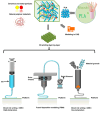Biocompatible Thermoplastics in Additive Manufacturing of Bone Defect Fillers: State-of-the-Art and Future Prospects
- PMID: 40870041
- PMCID: PMC12387413
- DOI: 10.3390/ma18163723
Biocompatible Thermoplastics in Additive Manufacturing of Bone Defect Fillers: State-of-the-Art and Future Prospects
Abstract
The development of materials engineering allows for the creation of new materials intended for 3D printing, which has become a key tool in tissue engineering, particularly in bone tissue engineering, enabling the production of implants, defect fillers, and scaffolds tailored to the individual needs of patients. Among the wide range of available biomaterials, thermoplastic polymers such as polycaprolactone (PCL), polylactic acid (PLA), polyether ether ketone (PEEK), and polymethyl methacrylate (PMMA) are of significant interest due to their biocompatibility, processability, and variable degradation profiles. This review compiles the latest reports on the applications, advantages, limitations, and modifications in bone tissue engineering. It highlights that PCL and PLA are promising for temporary, resorbable scaffolds, while PEEK and PMMA are suitable for permanent or load-bearing implants. The inclusion of ceramic phases is frequently used to enhance bioactivity. A growing trend can be observed toward developing customized, multifunctional materials that support bone regeneration and biological integration. Despite ongoing progress, the biocompatibility and long-term safety of these materials still require further clinical validation.
Keywords: PCL; PEEK; PLA; PMMA; biomaterials; bone; composites; hydroxyapatite.
Conflict of interest statement
The authors declare no conflicts of interest.
Figures








References
-
- Verrier S., Alini M., Alsberg E., Buchman S.R., Kelly D., Laschke M.W., Menger M.D., Murphy W.L., Stegemann J.P., Schütz M., et al. Tissue engineering and regenerative approaches to improving the healing of large bone defects. Eur. Cells Mater. 2016;32:87–110. doi: 10.22203/eCM.v032a06. - DOI - PubMed
-
- Lasanianos N.G., Kanakaris N.K., Giannoudis P.V. Current management of long bone large segmental defects. Orthop. Trauma. 2010;24:149–163. doi: 10.1016/j.mporth.2009.10.003. - DOI
Publication types
Grants and funding
LinkOut - more resources
Full Text Sources

